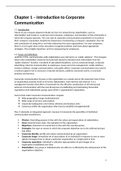Chapter 1 – Introduction to Corporate
Communication
1.1 Introduction
Future of any company depend critically on how it is viewed by key stakeholders, such as
shareholders and investors, customers and consumes, employees, and members of the community in
which the company operates. The core task of corporate communication practitioners is to protect
their company’s reputation. Despite the importance of protecting a company’s reputation, the role
and contribution of doing this is not fully understood by many organizations. For such companies,
there is a lot to gain when senior executives recognize problems and know about appropriate
strategies. This is highly important, and it is empowering for employees.
1.2 Scope and definitions
Until the 1970s, communication with stakeholders was referred to as “public relations”. This changed
when other stakeholders (internal and external) started to demand more information from the
“public relations” function. Consisted of specialized disciplines, such as corporate design, corporate
advertising, internal communication to employees, issues and crisis management, media relations,
investor relations, change communications, and public affairs. Corporate communication was used in
a tactical support role to announce corporate decisions, publicize corporate events, or promote
products and services.
Corporate communication focuses on the organization as a whole and on the important task of how
an organization presents itself to all its key stakeholders, both internal and external. It is a
management function that offers a framework for the effective coordination of all internal and
external communication with the overall purpose of establishing and maintaining favourable
reputations with stakeholder groups upon which is organization is dependent.
Factors that make Corporate Communication complex:
Wide geographical range (multinationals)
Wide range of services and products
Corporate headquarters and various divisions and business units
Consensus within the organisation often hard to establish (eensgezinsheid)
Also, it demands an integrated approach, because it transcends the specialities of individual
communication practitioners.
Mission: Overriding purpose in line with the values and expectations of stakeholders.
Vison: Desired future state, the aspiration of the organization.
Objectives: statement of overall aims in line with the overall purpose.
Strategies: the ways or means in which the corporate objectives are to be achieved and put
into effect
Corporate identity: profile and values communicated by an organization
Corporate image: immediate set of associations of an individual in response to one or more
signals/messages from or about a particular organization at a single point in time.
Corporate reputation: individual’s collective representation of past images of an
organization established over time.
Stakeholders: any group or individual who can affect or is affected by the achievement of the
organizations objective.
1
, Market: a defined group for whom a product is or may be in demand (and for whom an
organization creates and maintains product and services)
Communication: tactics and media that are used to communicate with internal and external
groups.
Integration: act of coordinating all communication so that the corporate identity is
effectively and consistently communicated to internal and external groups.
1.3 Trend in corporate communication
In 1980s, there was a powerful restructuring trend in many corporate organization where every
function within the organization was assessed based on its accountability and contribution to the
organization. This led to restructure separate communication disciplines into more integrated
departments. These functions all optimized their own performance, instead of working for the
organization as a whole. This change provided strategic direction to all of the organization’s
communication with different stakeholders groups.
In 1990s and 00s, communication became used in a more strategic sense to realize the organization’s
objectives. A downside of this is that stakeholders were cast as passive agents, thanks to implying a
linear model where the outcome off messages sent to stakeholders is already largely predetermined
or given.
In the recent years, stakeholders have taken a much more active role in corporate communication
empowered by new media technologies. This has caused a change towards interactive models of
communication. Stakeholders can now share experiences, opinions and ideas about organizations.
Whilst some mechanics have changed, people are more likely to become genuine advocates and
supporters. It is very important to understand how organizations communicate with stakeholders.
1970s: tactical support role for other functions, where its role was to announce decisions and
promote products and services.
1980s: communication became used in more strategic sense to realize organization
objectives and to build reputational capital with stakeholders.
The positioning paradigm: evolving in a new era of stakeholder engagement which brings
with it new points of emphasis around interactivity, authenticity, transparency and advocacy
(voorstander).
Challenges and opportunities through word-of-mouth and peer-to-peer influence.
Chapter 2 – Corporate Communication in
Contemporary Organizations
2.2 Integrated communication
Both marketing and public relations were separate “external” communication disciplines that needed
to concern themselves with issues of public concern, and with ways to effectively bring products to
the market. Since the 1980s, these two organizations started to bring these two together under the
umbrella called corporate communication, also referred to as integrated paradigm.
Explanation of the five models in the figure
Most companies practice model b, but a lot of companies are starting to embrace model e.
A. Before the 1980s, marketing (sense, serve, and satisfy customer needs at a profit) and public
relations (product goodwill with the company’s various publics so that these publics do not
interfere in the firm’s profit-making ability) were seen as two entirely separate disciplines.
2
, B. In the 1980s, it was recognized that marketing and public relations shared some common
ground. Marketing public relations (MPR) involves the use of public relations techniques for
marketing purposes, which was a very cost-effective tool for generating awareness and
brand favourability.
C. Marketing is seen as the dominant function. Here, public relations has become part of the
marketing function to satisfy customers. Integrated marketing communication (IMC) is seen
as recognizing the added value of a plan that evaluates the strategic role of different
disciplines.
D. Public relations is seen as the dominant function. Here, marketing’s role of satisfying
customers is seen as a part of the wider public relations effort to satisfy all stakeholders.
E. Marketing and public relations have merged into one and the same external communication
function.
In the 2010s, branded content emerged. The generation of content involves creating content that is
both product-related and about general interest in the company. MPR uses public relations
techniques, but are (in)directly focused on the marketing of a company’s products and services.
Corporate public relations (CPR) involves communication with investors, communities, employees,
the media and government.
3






